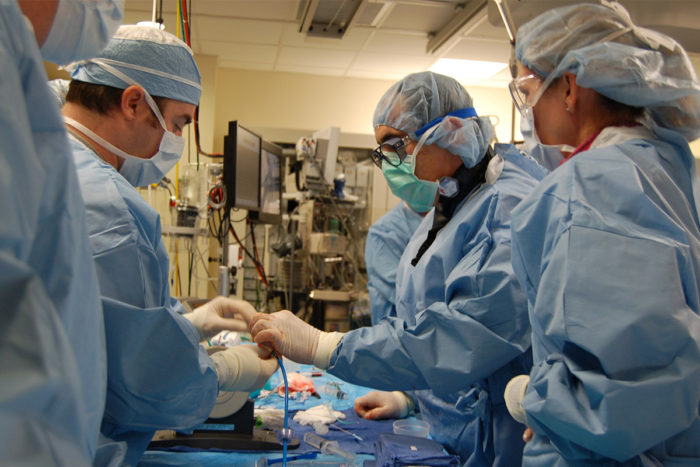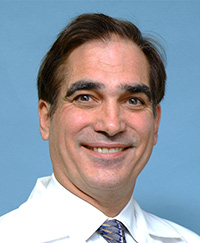New procedure makes valve replacement an option
A national trial shows that a procedure to replace a diseased heart valve is effective for patients too frail to undergo open-heart surgery

John M. Lasala, M.D., Ph.D., (center) medical director of the Cardiac Catheterization Laboratory, performs the first surgery in a trial to study transcatheter aortic valve implantation (TAVI) at the School of Medicine.
Three years ago, Mary Ann Cahalin’s heart was so poorly functioning that she was unable to walk up stairs. The aortic valve in the left pumping chamber of her heart had become narrowed with calcium deposits, limiting blood flow from her heart to the rest of her body. She could barely function.
Cahalin was so ill, in fact, that she could not qualify for surgery that may have helped her. Her chance of surviving open-heart surgery to replace her aortic valve was considered too poor to risk the procedure. Unfortunately, patients with her condition—inoperable severe aortic stenosis—typically face rapid decline following the onset of symptoms.
It was that poor prognosis, however, that brought Cahalin into a procedure room at Barnes-Jewish Hospital on January 15, 2008. There, she became the first patient in the St. Louis region to have her calcified aortic valve replaced without open-heart surgery.
Washington University physicians implanted a new valve into her heart by using a catheter, which was inserted into the femoral artery in her leg and threaded through her circulatory system to the heart. The artery was accessed through a small incision in the groin. Cahalin’s heart continued beating during the two-hour procedure.
“They did the procedure on a Tuesday, and I was home by Friday and had my hair done on Saturday,” says Cahalin. Four weeks later, the 81-year old mother of five participated in a Girl Scout camp out.
“I call it a miracle,” says Cahalin. “It changed my life.”
Procedure superior to medication
Cahalin’s procedure, called transcatheter aortic valve implantation (TAVI), is experimental, and she received it as part of a clinical trial. Results from the trial were published in the New England Journal of Medicine. They showed that in patients with severe aortic stenosis who were not suitable candidates for surgery, Cahalin’s procedure was superior to the standard therapy of medication—markedly reducing symptoms, the rate of death, and the rate of repeat hospitalization.

“The introduction of transcatheter valve replacement will go down as one of the innovative milestones in the history of cardiac surgery,” says Ralph Damiano Jr., MD, co-leader of the study and chief of cardiac surgery at Washington University and Barnes-Jewish Hospital. “It has the potential to dramatically reduce the risk of valve replacement, particularly in elderly, high-risk patients. We have seen a much quicker return to full activity in our patients with much less postoperative discomfort when compared to traditional open valve replacement through the breastbone.”
“This is a monumental breakthrough for aortic stenosis patients who are considered inoperable,” says study co-leader John Lasala MD, PhD, medical director of the cardiac catheterization laboratory at Barnes-Jewish Hospital.
A combined effort
The approach requires the combined efforts of Damiano and fellow cardiac surgeon Hersh Maniar, MD, and interventional cardiologists Lasala and Alan Zajarias, MD,—who perform the procedure together—as well as cardiologist Brian Lindman, MD, who performs echocardiographies, or heart ultrasounds, to evaluate valve positioning.
The team, including an interventional cardiologist and surgeon, guides the valve into position within the diseased aortic valve of the heart. Fluoroscopy imaging makes progress and positioning clearly visible on monitors. The procedure does not require stopping the heart.
When the new valve is positioned inside the calcified valve, the balloon expands to push the old valve aside and lock the new valve into place. The new valve, buttressed by the calcified flaps of the old valve, immediately takes over.
The first available study results concern only patients who participated in the transfemoral trial, where the catheter was inserted into the femoral artery in the leg. In this study, patients deemed too frail to withstand open-heart surgery but were approved for transfemoral catheter delivery were randomly placed in either a control group that received standard treatment, or a group that underwent the transfemoral valve replacement procedure.
The rate of death from any cause at one year was over 20 percent lower in the group that underwent TAVI than the group that received optimal standard therapy. This was a highly significant difference and there was also a significant improvement in quality of life and fewer hospitalizations.
With more than 50 TAVI procedures performed since 2008, Washington University surgeons and cardiologists have developed unique expertise in the procedure.
“Roughly half of these transcatheter implantations have been done transfemorally,” Lasala says. “It depends on what is best for the individual patient. The average patient age is 84, but we have done the procedure for patients up to age 98.”
Learn more about transcatheter valve replacement and the Washington University and Barnes-Jewish Heart & Vascular Center and watch Mary Ann Cahalin’s story.






